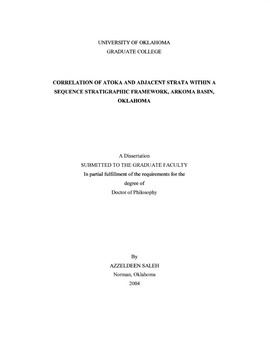| dc.contributor.advisor | Forgotson, James, | en_US |
| dc.contributor.author | Saleh, Azzeldeen A. | en_US |
| dc.date.accessioned | 2013-08-16T12:19:21Z | |
| dc.date.available | 2013-08-16T12:19:21Z | |
| dc.date.issued | 2004 | en_US |
| dc.identifier.uri | https://hdl.handle.net/11244/703 | |
| dc.description.abstract | The Atoka Formation in the Arkoma Basin represents the thickest stratigraphic interval. The purpose of this study is to delineate the stratigraphy of this formation in the entire Arkoma Basin in Oklahoma, using detailed well log correlations within a sequence stratigraphic framework. This includes establishing the criteria for defining the boundaries, lateral and shelf-to-basin distribution of the lower, middle, and upper units within the Atoka Formation. This framework helps to decipher relationships, in terms of relative age and depositional setting, for many lithostratigraphic sandstone units that have been reported in different parts of the basin. The study also includes, both the Union Valley-Wapanucka strata at the base of the Atoka Formation, and the Hartshorne-Booch strata, at its top. | en_US |
| dc.description.abstract | The Atoka stratigraphy is an integral part of the sequence stratigraphic realm that continued throughout Pennsylvanian time. The stratigraphic section starting from the Morrowan through the early Desmoinesian represents four third-order cycles of relative sea level changes. The section including the Cromwell sandstone through the Wapanucka prograding carbonate platform represents the Morrowan cycle. The basal Atoka LST, TST, and the lower Atoka HST represent the lower Atokan cycle. The middle Atoka LST, and the upper Atoka TST and HST represent the middle-upper Atokan cycle. Finally, the Hartshorne LST, TST, and the Booch HST represent the lower Desmoinesian cycle. Each cycle represents a third-order sequence bounded by unconformities. | en_US |
| dc.description.abstract | The Arkoma foreland basin is a mature exploration province that still has opportunities for further prospecting. It can serve as a stratigraphic model for other foreland basins because of the following advantages: the wide range of sedimentary environments, the complex interaction of tectonics and sediment supply and the availability of thousands of well logs. The conductivity log is available for almost all the wells drilled in the basin. Few wells have sonic logs, which is the norm in many mature basins. The good correlation between the conductivity and sonic logs can be employed to create 2-D and 3-D pseudo-seismic models that may help in understanding the stratigraphy and exploring in other foreland basins. | en_US |
| dc.description.abstract | The Arkoma foreland basin system consists of three depozones. The foredeep depozone is dominated by the thick deepwater turbidites. The forebulge depozone shows the highest rates of erosion along unconformities such as the Morrowan/Atokan and the middle Atokan unconformities. Shallow-water deposits and thin sedimentary section characterize the back-bulge depozone in the northwestern part of the Arkoma Basin. | en_US |
| dc.format.extent | vi, 181 leaves : | en_US |
| dc.subject | Sequence stratigraphy. | en_US |
| dc.subject | Geology, Stratigraphic. | en_US |
| dc.subject | Geology. | en_US |
| dc.subject | Arkoma Basin (Ark. and Okla.) | en_US |
| dc.title | Correlation of Atoka and adjacent strata within a sequence stratigraphic framework, Arkoma Basin, Oklahoma. | en_US |
| dc.type | Thesis | en_US |
| dc.thesis.degree | Ph.D. | en_US |
| dc.thesis.degreeDiscipline | Conoco Phillips School of Geology and Geophysics | en_US |
| dc.note | Source: Dissertation Abstracts International, Volume: 65-02, Section: B, page: 0619. | en_US |
| dc.note | Chair: James Forgotson. | en_US |
| ou.identifier | (UMI)AAI3122287 | en_US |
| ou.group | Mewbourne College of Earth and Energy::Conoco Phillips School of Geology and Geophysics | |
